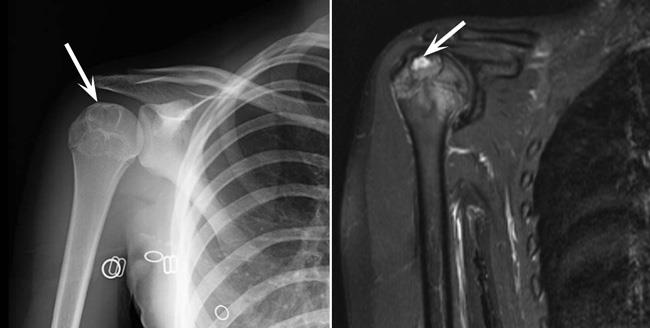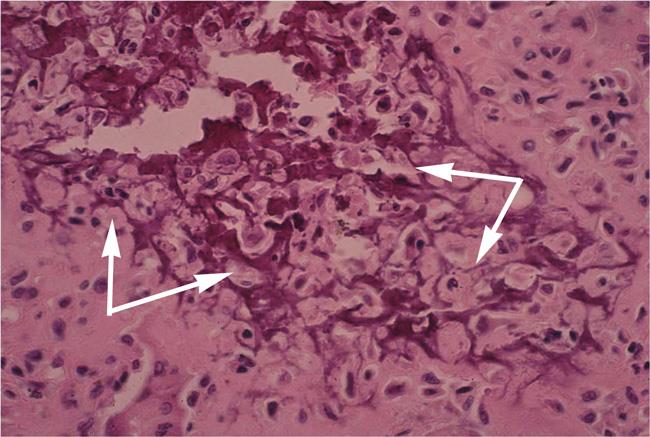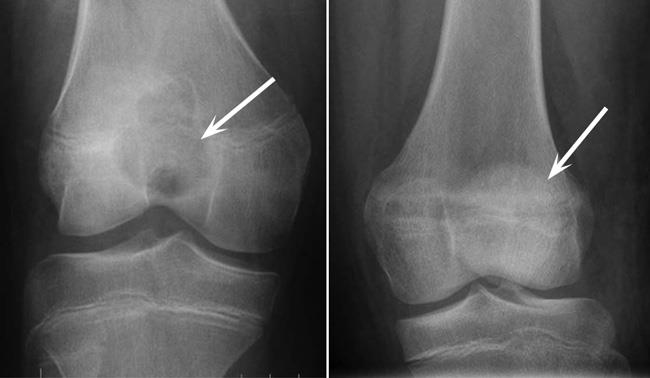Diseases & Conditions
Chondroblastoma
Chondroblastoma (kon-dro-BLAST-oma) is a rare type of benign (noncancerous) tumor that grows at the ends of the body's long bones, close to the joints. Most often, the tumors develop at the ends of the femur (thighbone), tibia (shinbone), or humerus (upper arm bone). They typically occur in children and young adults, and are more common in males.
Although chondroblastomas are not cancerous, they can continue to grow if left untreated. A growing tumor can destroy the surrounding bone, making it painful to move the nearby joint. Treatment for a chondroblastoma almost always involves surgery to remove the tumor and prevent damage to the bone near the affected joint.
Description
Most chondroblastomas are found close to the knee joint — either at the lower end of the femur (thighbone) or the upper end of the tibia (shinbone). They are also found in the shoulder at the top of the humerus (upper arm bone). This type of chondroblastoma is often referred to as a Codman's tumor. Less common locations for chondroblastomas include the pelvis, hip, and heel.
Chondroblastomas are made up of many cells that resemble fetal cartilage, which is how they got their name ("chondro" means cartilage and "blast" means embryo).
Most bones start out as cartilage. As a fetus grows, this cartilage is mostly replaced by bone. In children, the ends of the body's long bones contain a small section of cartilage called a growth plate. This is the area of the bone where growth occurs. When a child is fully grown, the growth plates close, hardening into solid bone. In many cases, chondroblastomas develop around the time that the growth plates start to close.
Males are twice as likely as females to develop chondroblastomas. Eighty percent of patients are under 25 years of age. The tumors are very rare, accounting for only about 1% of all bone tumors.
Chondroblastoma is one of the few benign bone tumors with the potential to spread, or metastasize, to the lungs. Even though a more aggressive chondroblastoma may metastasize, it is still considered a benign tumor.
Cause
The cause of chondroblastomas is not known. The tumors are thought to arise from the growth plates at the ends of the bones, near joints. However, chondroblastomas do not produce the same type of normal cartilage that makes up the growth plates or surrounds and protects the joints.
There has been no proven connection between the development of the tumors and exposure to chemicals or radiation or any particular activities.
Symptoms
Pain is the most common symptom of a chondroblastoma and often is present for a long time. Because the tumors are typically found near joints, it is joint pain that will often prompt a visit to the doctor. Over-the-counter pain medications such as acetaminophen and ibuprofen may help relieve this pain at first — but will become ineffective as the tumor grows in size.
Other signs and symptoms of a chondroblastoma may include:
- Joint stiffness
- Joint swelling
- Muscle atrophy (wasting away of the surrounding muscle from lack of use)
- A limp (when the tumor is in the lower extremities)
A chondroblastoma is usually small and contained within the bone, so patients do not normally see or feel a mass.
Doctor Examination
Physical Examination
The doctor will talk with you about your or your child's medical history and general health and ask about symptoms.
They will try to learn as much as possible about your or your child's pain. Pain at night or pain that does not go away with rest is usually more concerning. This is because pain caused by an injury will usually decrease when the injured area is not being used.The doctor will then examine the painful area, looking for:
- Tenderness over the bone
- Limited range of motion in the nearby joint
- Swelling around the joint
The doctor will use imaging studies and other tests to help diagnose a chondroblastoma.
Tests
X-rays. X-rays provide images of dense structures, such as bone, and are very helpful in diagnosing chondroblastomas.
Most chondroblastomas are small (1 to 4 cm), round tumors immediately adjacent to the ends of bones. On X-ray images, they are often surrounded by a thin rim of white bone. Some will cause the edge of the bone to push out, but rarely do the tumors extend past the bone and into the surrounding soft tissue. In about 25 to 40% of cases, an X-ray will show calcifications (white spots) inside the tumor.
Computerized tomography (CT) scans. More detailed than a plain X-ray, a CT scan can help the doctor further evaluate the tumor and plan your or your child's treatment. Calcifications inside the tumor are more likely to be visible on a CT scan.
Magnetic resonance imaging (MRI) scans. MRi scans provide clear images of the body's soft tissues. An MRI scan will help the doctor better see the edges of the tumor and determine whether it has expanded out of the bone and into nearby tissues. It will also show areas of inflammation that typically surround a tumor.
Biopsy. A biopsy is often necessary to confirm the diagnosis of chondroblastoma. In a biopsy, a sample of tissue is taken from the tumor and examined under a microscope.
A biopsy can be performed under local anesthesia with a needle or as a small open operation. Usually, a radiologist will perform the biopsy.
Under a microscope, chondroblastomas have a background that looks like cartilage and a mix of cells, some of which look like cartilage-making cells (these have nuclei that look like coffee beans). Calcifications may be seen weaving throughout the tumor in a pattern that resembles chicken wire.
Differential Diagnosis
Tests will help the doctor differentiate a chondroblastoma from other tumors that have a similar appearance, such as a giant cell tumor, enchondroma, aneurysmal bone cyst, infection of the bone (osteomyelitis), chondroblastoma-like osteosarcoma, or clear-cell chondrosarcoma.
It is very important to differentiate a chondroblastoma from a more aggressive tumor like a chondrosarcoma. A pathologist (a doctor who identifies diseases by studying abnormal cells) will review the tissue sample and do special tests to help determine the diagnosis.
Treatment
Without treatment, a chondroblastoma will likely continue to grow and destroy the surrounding bone, so treatment is almost always necessary. The goals of treatment are to:
- Remove the tumor
- Prevent damage to the bone and joint
Surgery is often the preferred treatment for chondroblastomas; however, there are some cases in which a tumor cannot be removed safely or effectively due to its location or size. In this case, the doctor may recommend nonsurgical treatment.
Nonsurgical Treatment
Nonsurgical treatment may include:
Radiofrequency ablation. In this procedure, the tumor is heated and destroyed with a high-frequency electrical current. This procedure works best for small lesions.
Cryotherapy. In this procedure, the tumor is destroyed using extreme cold produced by liquid nitrogen.
Both radiofrequency ablation and cryotherapy are typically used when more extensive surgery might lead to unacceptable complications.
Surgical Treatment
Most often, surgery is used to treat chondroblastomas. Surgical treatment may include:
Curettage. This is the procedure most commonly used to treat a chondroblastoma. In curettage, special instruments are used to scrape the tumor out of the bone. Once a chondroblastoma is curetted, it is unusual for it to return.
Bone graft. After curettage, the doctor may fill the cavity with a bone graft to help stabilize the bone. A bone graft is taken either from a donor (allograft) or from another bone in your body (autograft) — most often, the pelvis.
The doctor may also use a bone cement mixture to fill the hole. Sometimes, additional chemicals, such as phenol or liquid nitrogen, are placed inside the bone cavity to try to reduce the risk of recurrence.
Resection. Depending on the location and size of the tumor, the doctor may remove the entire section of bone containing the tumor, rather than performing curettage. Metal rods or plates and screws may then be used to stabilize the bone.
In rare cases, a chondroblastoma can spread to the lungs or other organs. If the tumor spreads, surgical removal of the bone, as well as the affected area of the organ, is necessary. This will typically result in a cure.
Surgical Complications
Recurrence of the tumor is the most serious complication of surgical treatment. Other potential complications include:
- Infection
- Rarely, fracture or collapse of the bone through the treated area
Outcomes
Your or your child's outcome after treatment will depend on a number of factors, including:
- Age and overall health
- The size and location of the tumor
- The method of treatment
Even with successful surgery, chondroblastomas can damage the normal cartilage that surrounds and protects the joints, so some patients may develop arthritis over time.
Chondroblastomas recur in approximately 10% of patients. The younger the patient, the more likely they are to have a recurrence.
If a tumor does recur, it usually does so within a few months to a few years. For this reason, the doctor will monitor you or your child with regular check-ups and X-rays for at least a few years. If a tumor recurs, it can be treated using the same methods. The doctor will talk with you about all of your options.
Last Reviewed
January 2022
Contributed and/or Updated by
AAOS does not endorse any treatments, procedures, products, or physicians referenced herein. This information is provided as an educational service and is not intended to serve as medical advice. Anyone seeking specific orthopaedic advice or assistance should consult his or her orthopaedic surgeon, or locate one in your area through the AAOS Find an Orthopaedist program on this website.









